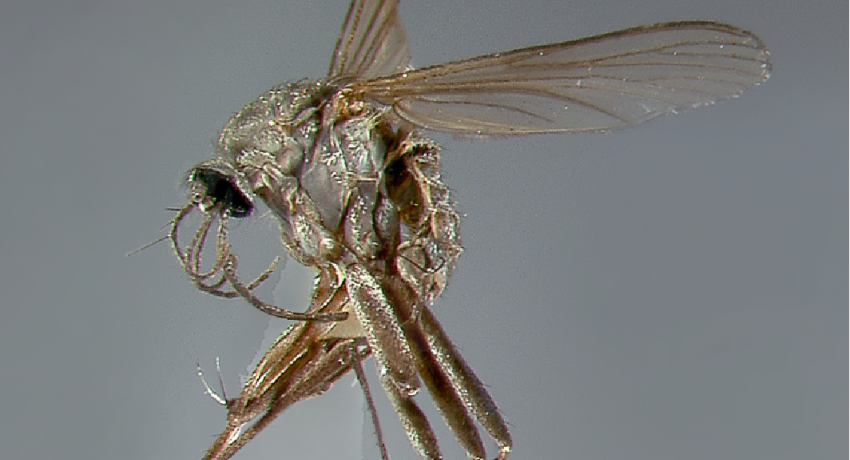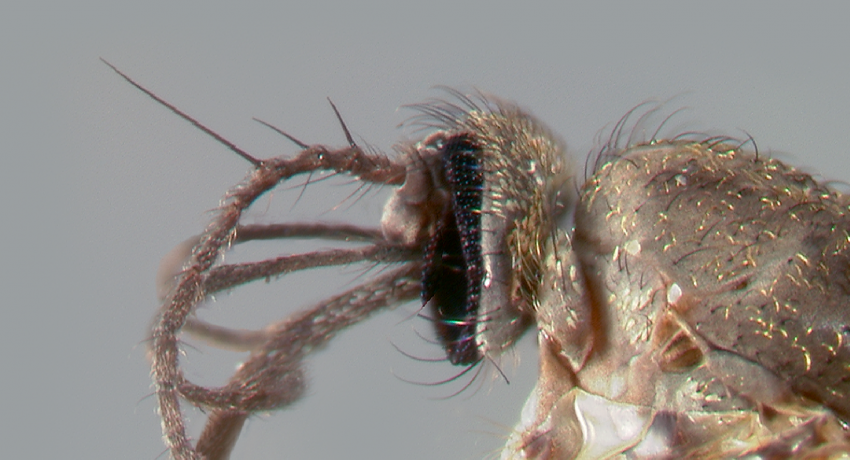AUSTRALASIAN REGION
Generic abbreviation: Op.
Type species: Opifex fuscus Hutton
Etymology: not stated. [worker or artisan (L)]
Despite there being only two species in the genus Opifex—both endemic to New Zealand—they are sufficiently distinct as to be placed into two separate subgenera: Nothoskusea (Op. chathamicus (Dumbleton)) and Opifex (Op. fuscus Hutton). Opifex chathamicus is endemic to the Chatham Islands and is by far the largest mosquito in New Zealand. It is very rare and recognized by their dark-scaled abdominal sterna with basal lateral pale patches and a pale apical median patch on some segments. Opifex fuscus Hutton is found on the North and South Islands, the Snares Islands and the Kermadec Islands.
DIAGNOSTIC CHARACTERS (Click photos to view; mouse over and click large photo to zoom in.)
ADULT (illustrated): Head: Antenna with a fully developed scape behind pedicel; vertex and occiput with short setae instead of erect scales; eyes widely separated. Wing: Subcostal vein short, with numerous basal setae. Legs: Unguis (U-I) long (Op. fuscus). Abdomen: Seta 6-I–V with ≥3 branches.
LARVA (not illustrated): Thorax: Seta 9–12-T reduced, single. Abdomen: Seta 7-I with ≥2 branches. Terminal segments: Saddle small; pecten spines few to absent.
TAXONOMIC KEYS
None
![]()
WRBU – Genera – Global – Larva
![]()
WRBU – Genera – Australasia – Adult
![]()
WRBU – Genera – Australasia – Larva
Exemplar DNA sequences
Op. fuscus arginine kinase gene: GQ906818
Op. fuscus CAD gene: GQ906843
Op. fuscus catalase gene: GQ906867
Op. fuscus enolase gene: GQ906891
Op. fuscus hunchback gene: GQ906915
Op. fuscus white gene: GQ906934
BIONOMICS
Immatures
Immature Op. chathamicus have been found in fresh to brackish water rockpools at or above the high tide line, at only three localities on the Chatham Islands. Opifex fuscus females are autogenous and oviposit in brackish to super-saline coastal rockpools, with a preference for sites that are occupied by conspecific immatures, perhaps related to mating.
Adults
Opifex males wait at the larval habitats and upon locating a mature pupa, the males grasp the respiratory trumpets with their extensive fore tarsal claws, waiting for the pupal case to split. If the emergent adult is a male, contact is broken; if female, copulation begins, even before the female has emerged from the pupal case. Oviposition is generally staggered over 3–12 days.
Although only eight adults of Op. chathamicus have ever been captured in the wild, all were collected in connection to people. Two females were collected at human bait on South East Island, one female indoors 2km from the coast at Wharekauri, and five specimens collected indoors at 22:00, southeast of Waitangi, some 5km from the shore. Wharekauri is 2km from the shore and Waitangi is more than 5km from the coast, suggesting that Op. chathamicus are either very strong flyers, or their preferred larval habitats may be less restricted than originally thought.
Although Op. fuscus primarily feeds on sea birds, it is a well-known nuisance to fisherman, and can deliver a painful bite. Experimentally, Op. fuscus is a competent vector for several alphaviruses.
*Associated pathogens: This list reports bacteria, viruses, and parasites recovered from, or experimentally passed through this species, and does not imply field vector status.
IMPORTANT REFERENCES (full citations below)
Hutton, 1902: 188 (in family Tipulidae; as genus, subg.)
Edwards 1921c: 73 (transfer to Culicidae)
Edwards 1932a: 127 (classification)
Belkin 1962 (taxonomy, bionomics; New Zealand)
Belkin 1968a (taxonomy, bionomics, distribution; as genus Opifex & subgenus Nothoskusea of genus Aedes)
Lee et al. 1984 (taxonomy; as subgenus Nothoskusea of genus Aedes)
Lee et al. 1988 (F; taxonomy, bionomics; as subgenus Opifex of genus Opifex)
Harbach & Kitching 1998 (phylogeny)
Reinert et al. 2004 (phylogeny, classification)
Reinert et al. 2006 (phylogeny, classification)
Reinert et al. 2008 (phylogeny, classification)
Reinert et al. 2009 (phylogeny, classification)
Wilkerson et al. 2015 (phylogeny, classification)
Soghigian et al. 2017 (molecular phylogeny)
VALID SUBGENERA
Nothoskusea Dumbleton [Not.]
Opifex Hutton [Opi.]
CURRENT GENERIC SYNONYMS
None
CITED REFERENCES
Belkin, J.N. (1962). The mosquitoes of the South Pacific (Diptera, Culicidae) (Vols. 1 &2). Berkeley, California: University of California Press.
Belkin, J.N. (1968a). Mosquito studies (Diptera, Culicidae) VII. The Culicidae of New Zealand. Contributions of the American Entomological Institute, 3(1), 1–182.
Edwards, F.W. (1921c). Mosquito notes. II. Bulletin of Entomological Research, 12, 69–80.
Edwards, F.W. (1932a). Diptera family Culicidae. In P. Wytsman (Ed.), Genera insectorum (194th Fascicule) (pp. 1–258). Brussels, Belgium: Louis Desmet-Verteneuil.
Harbach, R.E. & Kitching, I.J. (1998). Phylogeny and classification of the Culicidae (Diptera). Systematic Entomology, 23(4), 327–370.
Hutton, F.W. (1902). Additions to the Diptera fauna of New Zealand. Transactions of Zoology, 34, 179–196.
Lee, D.J., Hicks, M.M., Debenham, M.L., Griffiths, M., Bryan, J.H., & Marks, E.N. (1988c). The Culicidae of the Australasian region. Volume 10. Commonwealth Department of Health, School of Public Health and Tropical Medicine Monograph Series, 2.
Lee, D.J., Hicks, M.M., Griffiths, M., Russell, R.C., & Marks, E.N. (1984). The Culicidae of the Australasian region. Volume 3. Commonwealth Department of Health, School of Public Health and Tropical Medicine Monograph Series, 2.
Reinert, J.F., Harbach, R.E., & Kitching, I.J. (2006). Phylogeny and classification of Finlaya and allied taxa (Diptera: Culicidae: Aedini) based on morphological data from all life stages. Zoological Journal of the Linnaean Society, 148(1), 1–101.
Reinert, J.F., Harbach, R.E., & Kitching, I.J. (2008). Phylogeny and classification of Ochlerotatus and allied taxa (Diptera: Culicidae: Aedini) based on morphological data from all life stages. Zoological Journal of the Linnean Society, 153, 29–114.
Reinert, J.F., Harbach, R.E., & Kitching, I.J. (2009). Phylogeny and classification of tribe Aedini (Diptera: Culicidae). Zoological Journal of the Linnean Society, 157(4), 700–794.
Soghigian, J., Andreadis, T.G., & Livdahl, T.P. (2017). From ground pools to treeholes: convergent evolution of habitat and phenotype in Aedes mosquitoes. BMC Evolutionary Biology, 17, 262.
Wilkerson, R.C., Linton, Y.-M., Fonseca, D., Schultz, T., Price, D., & Strickman, D. (2015). Making mosquito taxonomy useful: A stable classification of tribe Aedini that balances utility with current knowledge of evolutionary relationships. PLoS ONE, 10(7), e0133602.
CITE THIS PAGE
Walter Reed Biosystematics Unit (Year). Opifex genus page. Walter Reed Biosystematics Unit Website, http://wrbu.si.edu/vectorspecies/genera/opifex, accessed on [date (e.g. 03 February 2020) when you last viewed the site].







